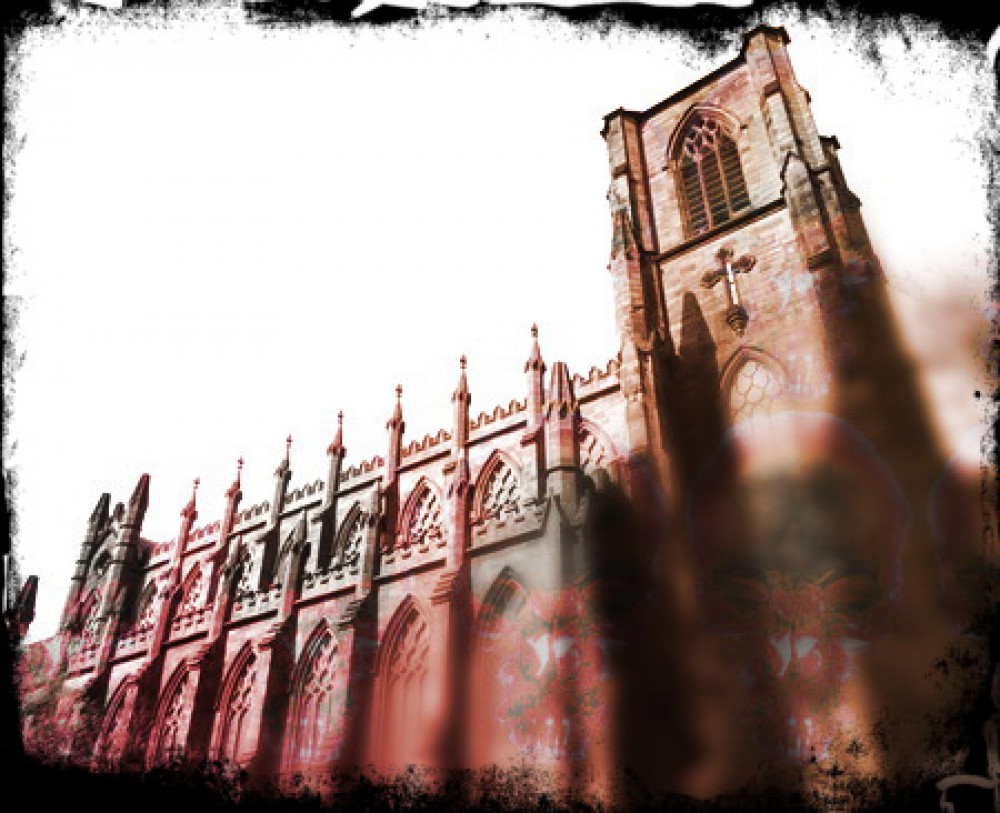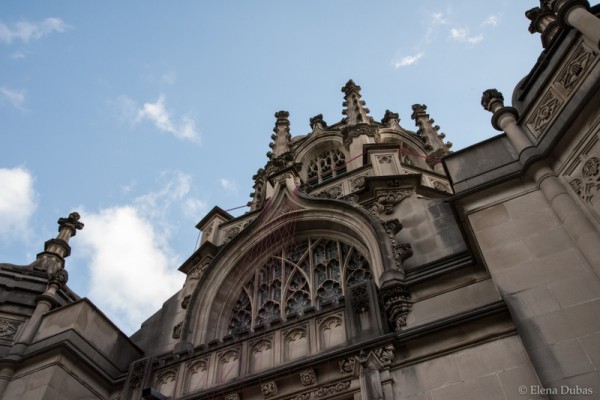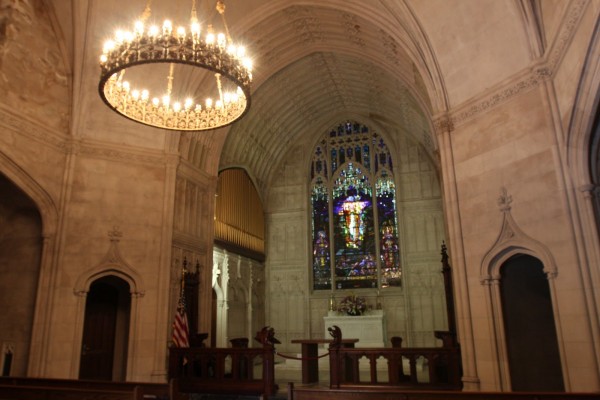History
The chapel was designed in 1911, 73 years after the establishment of the cemetery. It was built by Warren and Wetmore, the same architecture firm that produced Grand Central Station. The style is neo-gothic revival. Neogothicism was an architectural movement that took place in the 18th century. With the resurgence of Catholicism in Western Europe at this time, architects wanted to emulate Catholic designs. This contrasted with tamer neoclassical architecture.
Gothic Architecture is known for being very elaborate. It was popular during the renaissance period and was symptomatic of a time when people relinquished their hope for the mortal world. Art was pious in purpose and ostentatious displays of wealth even in death were directed at the divine. This religious materialism is ubiquitous in many Catholic art styles.
In 1885, architect, Richard Upton, planned for a “Gothic Revival style central-plan mortuary chapel” but in 1863 the cemetery voted against it. Currently the Steinway Mausoleum stands where it was originally supposed to be built. However in the early 1900’s they proceeded with the plan and built it on Arbor Water. They preferred the new site because of it’s proximity to the main entrance and because it could be constructed without altering the landscape.
Common gothic architectural features include: flying buttresses, finials, pointed arches, nave vaulting, spires, arches, stained glass windows. All these elements are on display in the Greenwood Cemetery Chapel. Horace Walpole, the author of “The Castle of Otranto” is widely credited for popularizing the neogothic revival movement when he constructed Strawberry Hill House in Twickenham, London. It is widely known that the man had a small obsession with everything gothic. This obsession pours out from his prose.
Many traditional structures served as inspiration for more modern architects, as is evident here with the greenwood cemetery chapel. In actuality, the chapel is based on the Tower at Christ Church Cathedral in Oxford, England and not Neuschwanstein Castle as was the inspiration for the Disney Castle.
Appearance
About fifty yards from the cemetery’s 25th street entrance, The Greenwood Cemetery Chapel sits nestled claustrophobically in a cul-de-sac of gravesites. Morning comes and the mist creeps up from the small pond that lies to the South. The shroud obscures the chapel’s nakedness; the ostentatious limestone facade normally left exposed by the small trees and shrubbery. The summery scene at the bottom of the hill is inappropriately green for one surrounded by so much death.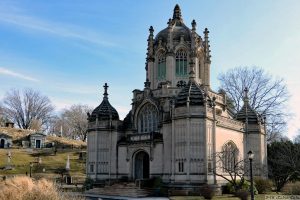
The chapel’s spires and cornices are stylistically consistent with the nearby entrance gate. Every inch of the building is heavily ornamented, even the corners are rounded out into turrets, topped by rounded cupolas. The cupolas themselves are ridged as if with the scales of a dragon, or sheets of rain on a window pane. There’s an unplaceable ugliness to it all and it mildly resembles the Disney Castle if hit with a shrink ray. Perhaps it’s the culmination of excessive domes and arches all crammed into its awkward stout frame. Given the pointed arches adorned with finials, floral moldings, spires and other such Gothic affectations, it’s hard to believe the chapel was designed by the same people responsible for Grand Central Station.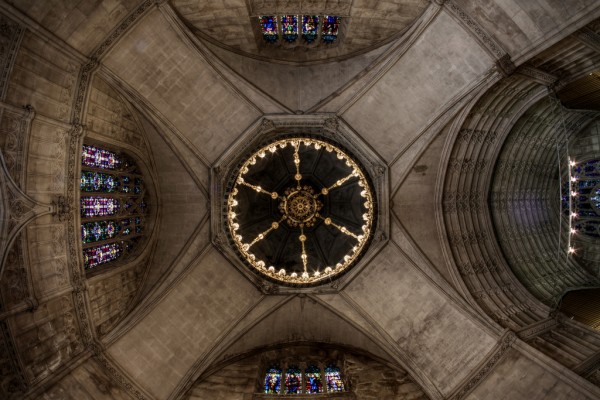
A chill runs through you upon entry, perhaps an otherworldly presence, or maybe it’s just the 24/7 air conditioning on full blast. A Roman chandelier hangs close overhead; a proverbial ring of fire. There are a few rows of pews and an altar-like stage, like that of an old courthouse. Stained glass windows take up most of the wall space, refracting dancing colors onto the floor.
There is a simplicity to the interior that can’t be seen from the outside. The likely cause of the interior’s relative sparsity is that unlike other Gothic churches, the chapel is non-denominational.
The Castle of Otranto
The chapel is reminiscent of the church of St. Nicholas in “The Castle of Otranto.” The church is a place of asylum, just as the chapel in Greenwood provides respite from the surrounding field of the dead. It is a solitary monument against the gloom. “’We must go down here,’ said Isabella. ‘Follow me; dark and dismal as it is, we cannot miss our way; it leads directly to the church of St. Nicholas. But, perhaps,’ added the Princess modestly, ‘you have no reason to leave the castle, nor have I farther occasion for your service; in a few minutes I shall be safe from Manfred’s rage—only let me know to whom I am so much obliged” (Walpole 45). In this passage, Isabella flees Manfred through the labyrinthian dungeons for the safety of the church.
The church also has a deeper significance. It serves as both physical and metaphorical salvation because the church is the one place people look to protect their souls from the horror of mortality. In the book Isabella seeks the church to preserve her physical body from Manfred’s unwanted lust and Manfred seeks Isabella to preserve his legacy. His hope is that she will bear sons and continue his family name, saving him from the metaphorical death that is promised. Manfred makes this point explicit to the friar: “Manfred, accompanied by the Friar, passed to his own apartment, where shutting the door, “I perceive, Father,” said he, “that Isabella has acquainted you with my purpose. Now hear my resolve, and obey. Reasons of state, most urgent reasons, my own and the safety of my people, demand that I should have a son” (Walpole 99). To Christians, this church represents the same hope that Isabella represents to Manfred and that she represents to him.
The greenwood chapel is similar because it also stands alone amidst tombs and mausoleums and protrudes with its beauty, despite its intimidating grandeur. The window dividing its dome is circular. Like an eye that god can peek through when he shines his spotlight on you. The church is the building the dead must pass through to leave this world, the promise that death isn’t the end.

Works Cited
Landmarks Preservation Commission. “GREEN-WOOD CEMETERY CHAPEL.” GREEN-WOOD CEMETERY CHAPEL, 2016, s-media.nyc.gov/agencies/lpc/lp/1233.pdf.
Walpole, Horace. The Castle of Otranto, a Gothic Story. Translated by William Marshal, Gent. from the Original Italian of Onuphrio Muralto .. Printed for Wenman and Hodgson, 1793.
